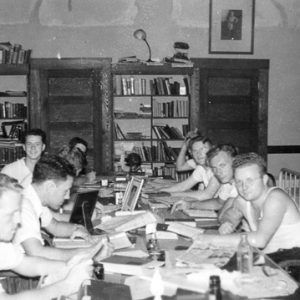calsfoundation@cals.org
St. John's Seminary
St. John’s Seminary opened in 1911 in Little Rock (Pulaski County) on Gaines Street as a wing of the Little Rock College for Boys. In its fifty-six-year run, the seminary produced hundreds of pastors, teachers, chaplains, and priests. The seminary was relocated to North Tyler Street in Little Rock’s Pulaski Heights neighborhood in 1916 but was closed in 1967 due to financial constraints and a shortage of trained faculty. Today, the campus is the home of the St. John Catholic Center, housing the administrative offices of the Roman Catholic Diocese of Little Rock.
St. John’s Seminary was started in September 1911 by Bishop John Baptist Morris, who decided the best way to obtain new priests was to open a seminary in Arkansas. In its first year, the school had only ten students, who ranged in age from high school freshmen to college graduates. The seminary had a high school department for a small number of boys who wanted to enter after finishing grammar school, along with a four-year college, which had a particular emphasis on ancient languages, such as Latin and Greek, and philosophy. The remaining four years were devoted to more philosophy, with a heavy concentration on theology. In its first twelve years, the seminary trained forty-five priests, including thirty-eight for its home diocese.
The seminary was first located in and operated in conjuction with the old Little Rock College at Twenty-fifth and State streets. In 1914, the diocese purchased a forty-acre plot at North Tyler Street in an area that was then predominantly wilderness, and the campus was built in 1916. When Little Rock College was forced to close in 1930, the property was turned over to St. John’s. By 1950, the institution had a capacity of 200 students.
In the 1960s, however, the seminary suffered due to high attrition rates. By 1967, with only fifty students enrolled at the school, the overall income was not enough to pay for the operating costs of the school. There was also a shortage of trained faculty members.
To make matters worse, turmoil erupted within the Arkansas Catholic community over some controversial articles written by one of the seminary’s priests. In the mid-1960s, the young faculty members at the seminary were far more liberal than most Arkansas Catholics and the bishop at the time. Father James F. Drane, a theologian at St. John’s Seminary, wrote a series of articles in the Arkansas Gazette questioning the Church’s position against artificial contraception. Drane further stated that he hoped to overthrow the “myth” of papal infallibility. Bishop Albert Fletcher suspended him from the priesthood in 1966; Drane then appealed to the Vatican, which backed Fletcher’s suspension of the priest.
The seminary was forced to close its doors in the summer of 1967. After its closure, the offices of the Diocese of Little Rock were moved from their downtown location into the campus of the former seminary, which opened in 1968 as the St. John Catholic Center.
Today, St. John Catholic Center houses several dozen offices of the diocese including Adoption Services, Catholic Charities, Little Rock Scripture Study, and Social Action. It comprises Morris Hall (the main building on the campus), the Dining Hall, Fitzgerald Hall, Fletcher Hall, Byrne Hall, and the McDonald Center, which was added after the seminary closed.
For additional information:
Butler, Frank J. Belonging: One Catholic’s Journey. Maryknoll, NY: Orbis Books, 2020.
Harget, Malea. “100 Years Ago, Bishop Morris Had a Vision for More Priests.” Arkansas Catholic, September 10, 2011. Online at http://www.arkansas-catholic.org/article.php?id=2697 (accessed February 8, 2022).
Hanson, Aprille. “St. John Center Campus Founded in 1916 as a College.” Arkansas Catholic, September 15, 2016. Online at http://www.arkansas-catholic.org/news/article/4872/St-John-Center-campus-founded-in-1916-as-a-college (accessed February 8, 2022).
“Historic St. John’s—It’s Still Very Much in Business.” Arkansas Gazette, September 17, 1967, p. 4E.
“History of St. John Catholic Center.” Diocese of Little Rock. http://www.dolr.org/st-john-catholic-center/history (accessed February 8, 2022).
“Seminary Closing: Bishop Cites Lack of People, Money.” Arkansas Gazette, July 13, 1967, p. 7A.
“St. John’s Provides Strength to the Catholics of Arkansas.” Arkansas Gazette, September 11, 1955, p. 3F.
Woods, James M. Mission and Memory: A History of the Catholic Church in Arkansas. Little Rock: August House, 1993.
Lauren White
Rogers, Arkansas


 Fitzgerald Hall
Fitzgerald Hall  Little Rock College Postcard
Little Rock College Postcard  Morris Hall
Morris Hall  St. John's Seminary Building
St. John's Seminary Building  St. John's Deacons
St. John's Deacons  St. John's Seminary Dorm
St. John's Seminary Dorm  St. John's Grotto
St. John's Grotto  St. John's Seminary Students
St. John's Seminary Students 



I grew up adjacent to the St. John campus. We young boys would go over and watch the seminarians play softball or touch football on their athletic field. After they were through, we would use the fields. We conversed with them and got to know some of them. I grew up thinking Catholics talked funny. Later I realized that most of them were from the northeast and it was just the seminarians’ Yankee accents and not a Catholic dialect.